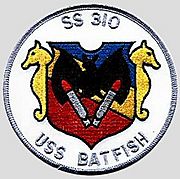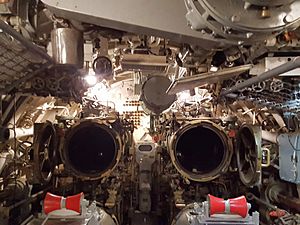USS Batfish (SS-310) facts for kids

|
|
Quick facts for kids History |
|
|---|---|
| Name | Batfish |
| Namesake | Batfish |
| Ordered | 21 April 1942 |
| Builder | Portsmouth Naval Shipyard, Kittery, Maine |
| Laid down | 27 December 1942 |
| Launched | 5 May 1943 |
| Sponsored by | Mrs. Nellie W. Fortier |
| Commissioned | 21 August 1943 |
| Decommissioned | 6 April 1946 |
| Recommissioned | 7 March 1952 |
| Decommissioned | 1 November 1969 |
| Stricken | 1 November 1969 |
| Honors and awards |
Presidential Unit Citation and 6 battle stars for World War II |
| Status | Museum ship in Muskogee, Oklahoma, 18 February 1972 |
| Badge |  |
| General characteristics | |
| Class and type | Balao class diesel-electric submarine |
| Displacement |
|
| Length | 311 ft 6 in (94.95 m) |
| Beam | 27 ft 3 in (8.31 m) |
| Draft | 16 ft 10 in (5.13 m) maximum |
| Propulsion |
|
| Speed |
|
| Range | 11,000 nautical miles (20,000 km) surfaced at 10 knots (19 km/h) |
| Endurance |
|
| Test depth | 400 ft (120 m) |
| Complement | 10 officers, 68 enlisted |
| Armament |
|
The USS Batfish (SS/AGSS-310) was a special type of submarine called a Balao-class submarine. It became famous during World War II for sinking three Imperial Japanese Navy submarines in just 76 hours in February 1945. These submarines were the Ro-55, Ro-112, and Ro-113.
The USS Batfish was the first ship in the United States Navy to be named after the batfish. This is a type of anglerfish that moves around on the ocean floor.
Batfish was active in World War II from December 1943 to August 1945. During this time, it completed seven war patrols. It is officially credited with sinking nine Japanese ships, which weighed a total of 10,658 tons. These operations took place in areas like the Philippine Sea and South China Sea. For its amazing sixth war patrol, where it sank three Japanese submarines, Batfish received the Presidential Unit Citation.
After World War II, the submarine was taken out of service in 1946. It was used for training for a while. In 1952, it was brought back into service and joined the United States Atlantic Fleet. It helped with training exercises in the Caribbean and along the East Coast of the United States. Batfish was finally taken out of service for good in 1969. In 1972, it became a museum ship in Muskogee, Oklahoma, where it has been ever since.
Contents
Building a Submarine Hero
The submarine, originally planned to be named Acoupa, was renamed Batfish on 24 September 1942. Its construction began on 27 December 1942 at the Portsmouth Naval Shipyard in Kittery, Maine.
The Batfish was launched into the water on 5 May 1943. Mrs. Nellie W. Fortier was its sponsor, a special role for ships. It officially joined the Navy on 21 August 1943, with Lieutenant Commander Wayne R. Merrill as its first captain.
World War II Adventures
After joining the Navy, Batfish spent time training its crew. They learned how to dive, attack, escape, and fix damage in combat. In October 1943, it began its journey to join the war in the Pacific.
While traveling, Batfish had a close call. A U.S. Navy patrol bomber aircraft almost dropped bombs on it, mistaking it for an enemy U-boat. The submarine safely passed through the Panama Canal and arrived at Pearl Harbor, Hawaii, on 19 November 1943.
First Patrol: Hunting in Storms
Batfish started its first war patrol on 11 December 1943, heading south of Honshu, Japan. The weather was very bad, with many typhoons, making it hard to find and attack Japanese ships.
On 19 January 1944, Batfish found a convoy of four Japanese ships. It attacked two cargo ships, sinking one and damaging another. The damaged ship, the Hidaka Maru, was sunk early the next morning. Batfish then returned to Midway Atoll for repairs and more training.
Third Patrol: Close Calls and Damage
On 26 May 1944, Batfish began its third patrol near the southern coasts of Kyushu, Shikoku, and Honshu. On 18 June, it claimed to have sunk a Japanese cargo ship.
A few days later, on 22 June, Batfish sank a larger Japanese cargo ship called Nagaragawa Maru. However, a Japanese patrol boat chased Batfish, forcing it to dive deep. The submarine accidentally hit an underwater volcanic peak, damaging its propeller shaft and propeller. Despite this, Batfish continued its patrol. On 2 July, it sank a converted yacht that was acting as an escort.
Fourth Patrol: Destroying Enemy Ships
Batfish left Midway Atoll on 1 August 1944 for its fourth patrol near the Palau Islands. It found two Japanese ships stuck on a reef and a Japanese destroyer, Samidare, also aground.
On 23 August 1944, Batfish attacked a Japanese minesweeper, which it thought was a destroyer. It fired three torpedoes, blowing the warship apart. A few days later, on 26 August, Batfish damaged the Samidare beyond repair with two torpedo hits. The Japanese later finished destroying Samidare themselves.
Sixth Patrol: The Submarine Hunter
The sixth war patrol, starting on 30 December 1944, was the most famous for Batfish. It was part of a group of submarines patrolling the South China Sea.
On 9 February 1945, Batfish detected a Japanese submarine using its radar. After an initial attack missed, Batfish fired again, sinking the submarine. This was later identified as the Ro-55.
Just two days later, on 11 February 1945, Batfish found another Japanese submarine. It fired four torpedoes, and the first one hit, blowing the enemy submarine apart. This was the Ro-112.
Then, on 13 February 1945, Batfish detected a third Japanese submarine. It fired three torpedoes, and the first one hit, causing a huge explosion and sinking the Ro-113.
In an amazing feat, Batfish had sunk three enemy submarines in just four days! This was a rare achievement. For this incredible patrol, Batfish received the Presidential Unit Citation.
Seventh Patrol: Lifeguard Duty
Batfish began its seventh and final war patrol in July 1945, serving as a "lifeguard" submarine. This meant it was ready to rescue United States Army Air Forces pilots who might crash into the sea.
On 26 July 1945, Batfish rescued three survivors from a crashed B-25 Mitchell bomber. On 15 August 1945, Japan surrendered, and Batfish was ordered to stop its combat operations.
Life After War
After World War II ended, Batfish returned to Pearl Harbor and then to San Francisco, California. It was taken out of service on 6 April 1946 and stored as a training vessel.
In 1952, Batfish was brought back into service. It spent the next years training sailors in the Caribbean and along the East Coast of the United States. It was finally taken out of service for good on 4 August 1958. For a while, it served as a training vessel for the United States Naval Reserve in New Orleans, Louisiana. Its name was removed from the Navy's list of ships on 1 November 1969.
Awards and Recognition
Batfish earned several important awards for its service:
 Presidential Unit Citation for its sixth war patrol.
Presidential Unit Citation for its sixth war patrol.- American Campaign Medal
- Asiatic-Pacific Campaign Medal with nine battle stars for its World War II service.
- World War II Victory Medal
- National Defense Service Medal with star
A Museum Ship in Oklahoma
Inspired by another submarine museum, the Oklahoma chapter of the United States Submarine Veterans of World War II decided to get a retired submarine for their state. In 1971, they successfully applied to the Navy to acquire the Batfish.
Moving the Submarine Inland
On 9 December 1971, the Navy officially gave Batfish to the Oklahoma Maritime Advisory Board. Moving a submarine so far inland was a huge challenge! First, it was towed from Orange, Texas, to New Orleans. There, it was placed between several large barges to make it shallow enough to travel up the Arkansas River.
The journey upriver was slow, at about 4 miles per hour. On 3 May 1972, Batfish passed through a lock and dam easily. However, its top part almost didn't fit under a bridge near Little Rock, Arkansas. The United States Army Corps of Engineers had to lower the river level by 3 feet for it to pass.
Batfish arrived at the Port of Muskogee Terminal on 7 May 1972. This was its temporary home. On 4 July 1972, it unofficially opened to the public. After a special trench was dug, Batfish was moved to its permanent spot. It officially opened on Memorial Day weekend in May 1973 at what is now Muskogee War Memorial Park: Home of the USS Batfish.
Recent Flooding and Future Plans
In May 2019, the Batfish suffered about $150,000 in damage during floods from the Arkansas River. The water filled the area around it, causing the submarine to float for the first time in decades. While the hull stayed watertight, the local fire department had to fill its ballast tanks with water to keep it stable. The park and grounds are open, but the Batfish itself was closed to visitors for a time.
As of August 2025, there are plans to move the Batfish to Three Forks Harbor in Muskogee. This move is part of a larger $28 million project that includes building a new Oklahoma War Memorial and Museum. The plan involves building boat ramps, trailering the ship, and then loading it onto a barge for the final move. The Oklahoma State legislature approved $4 million in funding for this relocation in May 2025. The museum moved to a temporary spot at Three Forks Harbor on July 1, 2025.



